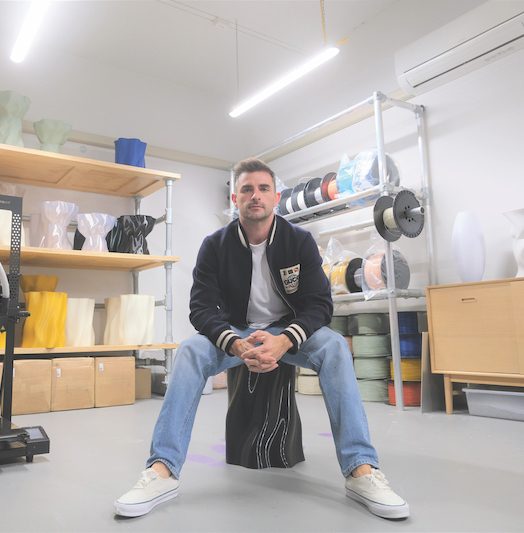Matt Watkins in his studio. Courtesy: Special Studio, Tauranga, New Zealand
How did you get into the design industry?
I’m not formally trained in design or additive manufacturing but have worked in product design for the past 10 years or so. I always enjoyed making things and after high school I started an apprenticeship making cabinetry. An accident with a table saw put an end to that. I spent time working in retail and wholesale for a few years before launching a software/hardware startup that made products for the DJ and live performance industry. I successfully exited that business in 2018 and I stayed on working for the company that acquired the business in a role as Product Officer. Now I’m full time at Special Studio.
Can you tell us how Special Studio originated?
I wanted to find a solution to the plastic waste problem so I set about researching the best way to recycle waste plastic into high value products. Originally I aimed to use waste plastic to produce full scale architecture helping to solve both affordable housing and reuse waste plastic. That’s still the ultimate goal and Special Studio, established officially in 2018, is the first step toward this. As we sell products, the funds will go toward building the capability to print an entire home.
Your objects beautifully nod to the natural world. What is the aesthetic inspiration Special Studio?
Additive manufacturing allows for design freedoms that are not possible with other forms of manufacturing, so I always try to design something that’s entirely unique. Sometimes, as in the case of the Lulu range, I wanted something fluid, soft and natural; other times the designs are symmetrical and sharp. My design process is very organic and I don’t follow any specific rules, in fact, it’s more about breaking rules than following any set design pattern. I feel that it would be a shame to design objects that are not totally unique. My lack of official design training combined with my experiences of the manufacturing process helps me produce objects that no one else can. At least for now.
Tell us more about the materiality of Special Studio designs, specifically talking about One Earth Technologies and your use of recycled plastics.
I believe that single use applications for plastics are a total waste and that single use plastic products should be phased out. It’s easy to ban plastics, but it’s difficult to know what to do with all of the plastic that’s already been produced. While plastics (polymer is the correct term) have been demonised, they are actually really amazing materials. Polymers are cheap to produce in dollar and carbon terms, are durable, which is part of the problem, and relatively easy to process. The problem isn’t the material, it’s the way we dispose of it. It’s a behavioural problem. So for me, it was about finding ways to use this material to its full potential and finding ways to reuse waste plastics. These materials are strong, light and can be produced in a range of colours, can be transparent, matte or gloss. This means Special Studio can produce a range of products from furniture to lighting and beyond. I think recycled plastics are great, but it’s important to make sure they are reused and don’t end up in nature.
Where is the studio currently located and do you have a large team?
It’s been just me up to this point, with help from a couple of friends part time. Investors are coming on board soon and we are getting ready to hire. The studio is based in Tauranga, New Zealand with a new showroom and studio opening soon.
Do you have an art/design collection at home and if so, are there any standout pieces?
I don’t really have much of an art collection, the pictures on my walls are my own and I have a bunch of Special Studio products throughout my house, mostly seconds that I cannot sell. Most of my design collection is in clothing and fashion. My favorite brands are Molly Perkinson, Always Do What You Should Do, Gucci, FM 669 and NEUW Jeans.
What’s on the horizon for Special Studio?
Special Studio is really only just getting started. The current range is the first of many, but right now we can’t produce fast enough so we really need to scale up so that we can meet demand and release the ranges that are designed and ready to go. We will be launching into the US and Australian markets by setting up production units in each location. This distributed approach allows us to circumvent international shipping and lowers the carbon footprint of our products. We are also working with some super talented designers from LA on a few of their designs, but I can’t say much more about that. In the short term, fitting out our first public facing studio is going to be super exciting.
Being a New Zealand-based design studio, how important is it to support local designers?
Super important, every dollar spent in NZ stays here and there are so many talented designers in NZ but it’s almost impossible to make anything locally, at least it was before digital fabrication became a thing. Being a designer is not enough though, one needs to be able to make products too, there’s a bunch of NZ based design brands that don’t produce here which is understandable but not impossible to do so and I think more brands should commit to local production. It’s one thing to design a cool product, making something real is a whole different challenge. While the tech we use is still relatively new and expensive, I don’t think it will be long before most products will be made locally in the market that it’s sold in. It’s not just about supporting local designers, it’s important to choose locally sourced and manufactured products.

